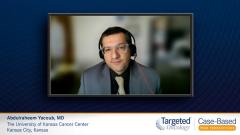
Future Directions in Myelofibrosis Treatment
Abdulraheem Yacoub, MD, offers closing thoughts on the future myelofibrosis treatment landscape, with a focus on treatments under investigation.
Episodes in this series

Case: A 68-Year-Old Woman with Myelofibrosis
- A 68-year-old woman presented to her physician with symptoms of mild fatigue, moderate night sweats, and abdominal pain/fullness lasting 4 months; she also reported increased bruising and unexplained weight loss
- Spleen was palpable 8 cm below the left costal margin
- Genetic testing shows a JAK2 V617F mutation; CALR negative; Karyotype: 46XX
- Bone marrow biopsy: megakaryocyte proliferation and atypia with evidence of reticulin fibrosis
- Blood smear reveals leukoerythroblastosis
- Diagnosis: Primary myelofibrosis
- Risk: DIPSS: Intermediate-2; MIPSS70: Intermediate risk
- Labs demonstrate:
- RBC 3.40 x 1012/L
- HGB 13.2 g/dL
- HCT 36%
- MCV 94 fL
- WBC 23.0 x 109/L
- PLT 450 x 109/L
- PB Blasts 1%
Transcript:
Abdulraheem Yacoub, MD: This is an exciting time for myelofibrosis research. Based on the success of JAK inhibitors in myelofibrosis, a big wave of combinations have sprung. The therapy with ruxolitinib is not universally active in all patients. Although some patients benefit from ruxolitinib, the benefit can be suboptimal. Eventually, everybody on ruxolitinib will progress and lose their benefit if you follow them long enough. Based on these imperfections or suboptimal situations, many approaches were adopted to investigate whether a combination—ruxolitinib and an additional agent, with reasonable clinical activity and safety—would be a successful approach for patients. It started as an add-on approach, but now there are many phase 3 studies investigating a combination up front in the majority of patients. One of the leading agents is parsaclisib, a PI3K inhibitor. Other leading agents are pelabresib, a BET inhibitor; venetoclax, a BCL2 inhibitor; selinexor; and an MDM2 inhibitor, siremadlin.
There are many agents in the first-line setting being investigated as a possible combination therapy, with the goal of achieving a faster response in the majority of patients, with a better quality [of life] that will last longer. Hopefully 1 or more of these combinations will be successful and result in a different style of care in the near future. Some agents are also being investigated as a single agent. More detail is necessary before we make any conclusions on this.
In addition, there have been a few novel, first-in-class agents that we’re excited about. For years, we recognized that calreticulin is a new mutation that’s unique to myelofibrosis and other MPNs [myeloproliferative neoplasms] because it results in a new protein that is excreted and binds the surface of the receptors. This can potentially be a target for immunotherapy or a targeted monoclonal antibody. Now we have an active monoclonal antibody that could bind to that and result in activity against myelofibrosis. We’re very excited about that. That’s in phase 1 studies.
There are also agents being evaluated for survival advantages, such as tagraxofusp and imetelstat, in which non-JAK-inhibitor-based agents are potentially of benefit in patients if JAK inhibitors aren’t successful and the patients might benefit from alternative therapeutic options. There’s a lot of momentum in our clinical trials with unique trial designs and end points of studies. Hopefully, the fruit of all that work will result in a lot of benefit to our patients, the future of myelofibrosis therapy will expand, and patients will have more options to live longer and better.
Transcript edited for clarity.









































